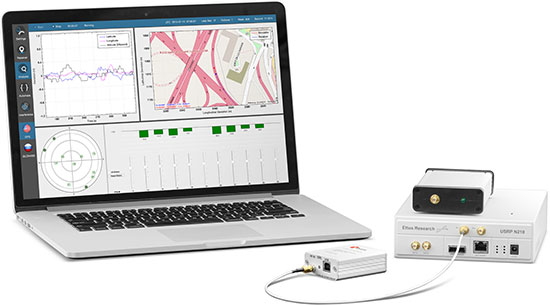|
I am a Postdoc at Sigcom in Luxembourg, working with Prof. Symeon Chatzinotas. Prior to my postdoc, I was a Ph.D. Student at Eurecom, Communications System Department, Biot in France, working under the supervision of Dr. Florian Kaltenberger. I worked on developing methods to mitigate cross technology co-channel interference in random access networks. The methods were used to develop an architecture for Multi-Standard Software Defined Radio capable of decoding signals from more than one wireless standard simultaneously. The Ph.D. was in collaboration with Siemens AG Corporate Technology, Munich, Germany.
Email / CV / Google Scholar / LinkedIn
My Youtube channel on GNU Radio and USRP (Old but useful!)
|
 |
|
My current research interests lies in integration of 5G terrestrial systems with Non-terrestrial Networks (NTN) such as Satellites, Drones and High Altitude Platform Systems(HAPS). My research balances both theoretical development and system building.
|
|
[11 May, 2020] One paper accepted at European Microwave Week 2020, Netherlands. [2 Feb, 2020] Two Demos accepted at ICASSP 2020, Barcelona. [6 Sept, 2019] A journal published at EURASIP Journal on Wireless Communications and Networking. [3 July, 2019] Demo of Joint MIMO Radar MIMO Communication at SPAWC 2019 [3 June, 2019] Joined as a postdoc at Sigcom group, SnT Luxembourg! [12 April, 2019] Successfully defended my Ph.D. thesis :) [1 April, 2019] One journal accepted in https://jwcn-eurasipjournals.springeropen.com/. [16 Feb, 2019] Submitted my thesis finally! Defense schedulled on 12th April 2019. :D Hope for the best. [Jan, 2019] One paper accepted in WCNC 2019. [Oct, 2018] Demonstration accepted in ACM MobiCom 2018. [Aug, 2018 ] One paper accepted in WiMob 2018. [June, 2018 ] One Patent granted! [June, 2018 ] Invited demonstration in SPAWC 2018. [April, 2018 ] One paper accepted in EuCNC 2018. |
|

|
|

|
|

|
|
|
|

|
|

|
|

|
|

|
|
|
|
|
Sumit Kumar, Deepti Singhal, Garimella Rama Murthy in Wireless Technologies: 3G and Beyond, Publisher: Springer May 2013. |
|
Sumit Kumar, Deepti Singhal, Garimella Rama Murthy in Intelligent Wireless sensor networks, Publisher: Taylor & Francis LLC, CRC Press, December 2012. |
|
|

|
In this project, I developed standard compliant IEEE 802.11g transceiver using, Openairinterface , Ettus UHD and USRP B210. MCS 0,2,4 were implemented. The receiver was capable of decoding packets from commercial IEEE 802.11g dongles with an accuracy of 90% while the packets generated by the transmitter were detected by commercial IEEE 802.11g dongles with 100\% accuracy. However, bidirectional communication with commercial dongles was not possible due to the high latency imposed by the USB 3.0 interface. Even for the PCI connector based USRP X300 was not able to satisfy the latency requirements for bi-directional IEEE 802.11g communication. A report on my latency measurement can be found here: USRP B210 and USRP X300 Latency Test Report . |

|
In this work, I developed a real-time single and dual antenna IEEE 802.11g receiver capable of mitigating multiple co-channel narrowband IEEE 802.15.4 interference in the 2.4 GHz band. Log-likelihood ratios of affected OFDM subcarriers were scaled in proportion to the noise variance induced by interferers. The receiver was tested against standard compliant transmitters. A combination of GNU Radio and Openairinterface was used along with Ettus USRP B210. This work was presented at SPAWC 2018 and ACM MobiComm 2018. Here is the video of my demonstration Demo video |

|
This project involved the development of a real-time Soft Bit Maximal Ratio Combiner (SBMRC) for multi-antenna IEEE 802.11g receivers. SBMRC receiver combines the log-likelihood ratios instead of complex samples and achieves similar performance as conventional Maximal Ratio Combiner. The receiver was tested against standard compliant transmitters. A combination of GNU Radio and Openairinterface was used along with Ettus USRP 210. This work is submitted to Eurasip Journal of Wireless Communication and Networking. |

|
In this work, I prepared a testbed for cognitive radio based wireless sensor networks. Major tasks were the development of spectrum sensing methods such as energy detection, cooperative spectrum sensing and spectrum monitoring which were integrated into the testbed. GNU Radio version 3.4.0 and Ettus USRP 1 were used. |

|
This work included the development of non-contiguous OFDM in GNU Radio for transmission in the presence of narrowband co-channel incumbent users. GNU Radio version 3.4.0 and Ettus USRP 1 were used for the implementation. I have used a package named Jello for this implementation. Here is a video demonstration . |

|
The GNU Radio package for IEEE 802.11g which is gr-ieee 802.11 has hard decision receiver. For my thesis, I needed soft decision receiver. In this project, I took the soft decision Viterbi decoder of Openairinterface IEEE 802.11g package and integrated into gr-ieee 802.11. Currently, the module has support for MCS 0 only and work for other MCS is under progress. GNU Radio V3.7.1 was used. Here is a demo video . |

|
This work is a byproduct of my work on narrowband interference mitigation in IEEE 802.11g . I used ZigBee (uses PHY of IEEE 802.15.4 and has bandwidth of 2 MHz, operates in 2.4 GHz band) as the narrowband co-channel interferer. Once the narrowband interferers collide with the preambles of IEEE 802.11g, the corresponding increase in the noise variance can be used to detect the presence of the narrowband interferers. I used GNU Radio V3.7.1 for USRP B210 for this work. Here is a demo video . |

|
This work is a proof of concept demonstration of Simultaneous Multi-Standard Software Defined Radio. It demonstrates the required operations such as channelization, frequency translation, filterign etc, in order to receive collocated IEEE 802.11g and ZigBee. Here is a demo video . |
